Global Smartphone Market: By Operating System, By Price Range, By Sales Channel, By Region & Segmental Insights Trends and Forecast, 2024 – 2034
- Industry: Semiconductors & Electronics
- Report ID: TNR-110-1121
- Number of Pages: 420
- Table/Charts : Yes
- June, 2024
- Base Year : 2024
- No. of Companies : 10+
- No. of Countries : 29
- Views : 10177
- Covid Impact Covered: Yes
- War Impact Covered: Yes
- Formats : PDF, Excel, PPT
Smartphones have become indispensable tools in modern life, serving as multifunctional devices for communication, entertainment, productivity, and more. With advanced features like high-resolution cameras, powerful processors, and expansive displays, smartphones have revolutionized how people interact with technology and each other. In addition to traditional calling and texting, smartphones enable users to access a wide range of applications and services, from social media and gaming to productivity tools and digital wallets. The integration of artificial intelligence (AI) and machine learning further enhances the user experience by personalizing content and providing intuitive interfaces.
Moreover, smartphones serve as hubs for capturing and sharing memories through photos, videos, and social media platforms. The evolution of mobile photography and videography has democratized content creation, empowering users to express themselves creatively and share their experiences with the world. As smartphones continue to evolve and innovate, they are poised to play an even greater role in shaping how people connect, work, and entertain themselves in the future.
One significant demand driver for smartphones is the constant evolution of technology. Consumers are consistently drawn to newer models featuring advancements such as improved processors, enhanced camera capabilities, and innovative display technologies. These technological upgrades not only attract tech enthusiasts but also prompt existing smartphone users to upgrade to the latest devices to access cutting-edge features. Another key driver is the increasing reliance on smartphones for various aspects of daily life. From communication and productivity to entertainment and e-commerce, smartphones have become indispensable tools for navigating the modern world.
As such, the demand for smartphones is fuelled by the need for connectivity, convenience, and access to a wide range of digital services. Moreover, competitive pricing and promotional offers from manufacturers and retailers play a crucial role in stimulating demand. Discounts, trade-in programs, and financing options make smartphones more affordable and accessible to a broader consumer base, further driving market demand for these essential devices.
In terms of revenue, the global smartphone market was worth US$ 570.3 Bn in 2023, anticipated to witness CAGR of 6.5% during 2024 – 2034.
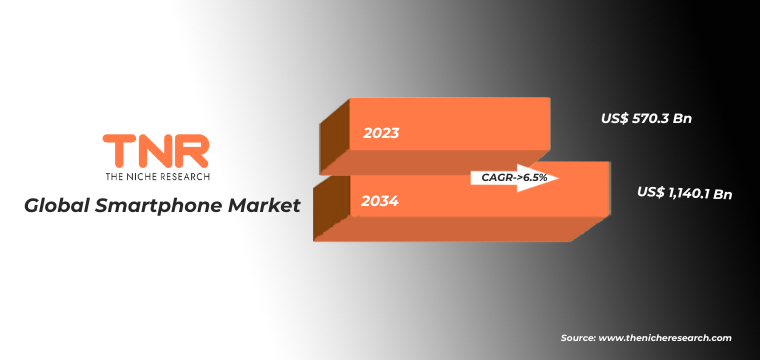
Global Smartphone Market Dynamics
Consumer Preferences and Trends: Changing consumer preferences, influenced by factors like design, features, brand loyalty, and lifestyle trends, shape the demand for smartphones. For example, the increasing focus on sustainability and eco-friendliness is influencing smartphone designs and materials. Rapid advancements in technology, such as 5G connectivity, improved processors, better cameras, and enhanced battery life, drive consumer demand for newer smartphone models.
Emerging Markets: Growth opportunities in emerging markets, driven by rising disposable incomes, urbanization, and increasing internet penetration, are reshaping the global smartphone market landscape, with manufacturers targeting these regions for expansion. Increasing awareness about environmental sustainability is prompting smartphone manufacturers to adopt eco-friendly practices in production, packaging, and recycling, influencing consumer choices and market dynamics.
Digitalization: Intense competition among smartphone manufacturers, including established players like Apple and Samsung, as well as emerging brands from China and other regions, fuels innovation and drives down prices, benefiting consumers. The increasing digitization of services and activities, including mobile banking, e-commerce, and streaming media, drives the need for smartphones as essential tools for accessing these services.
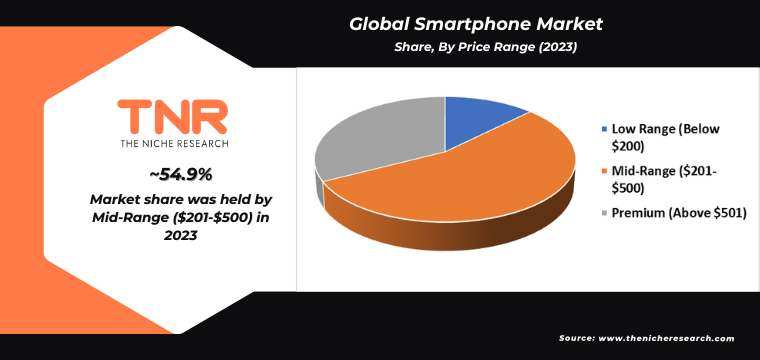
Android Segment Has Garnered Major Market Share in the Global Smartphone Market During the Forecast Period (2024 – 2034).
Android smartphones are driven by several key demand drivers, particularly in the Asia-Pacific region. Firstly, the affordability and versatility of Android devices cater to a broad spectrum of consumers, from budget-conscious individuals to tech enthusiasts seeking high-end features. This accessibility has fuelled widespread adoption, especially in emerging markets where price sensitivity is high.
Moreover, Android’s open-source nature enables smartphone manufacturers to customize and innovate their devices to cater to diverse consumer preferences. This flexibility leads to a wide range of Android smartphones with varying designs, features, and price points, ensuring there’s something for everyone in the market. Furthermore, the Android ecosystem benefits from the extensive availability of apps and services on the Google Play Store, offering users a rich and diverse digital experience. The integration of Google services, such as Gmail, Maps, and YouTube, enhances the value proposition of Android devices, driving consumer demand and loyalty in the competitive smartphone market.
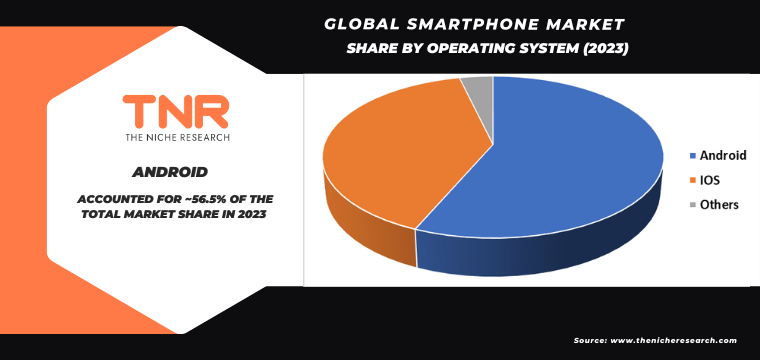
By Sales Channel Online Segment had the Highest Share in the Global Smartphone Market in 2023.
One primary factor boosting demand through online channels is the convenience they offer to consumers. With the proliferation of e-commerce platforms and mobile apps, purchasing smartphones online has become increasingly accessible, allowing consumers to browse, compare, and purchase devices from the comfort of their homes. Moreover, online sales channels often provide a wider selection of smartphones from various brands, models, and configurations compared to brick-and-mortar stores.
This variety caters to diverse consumer preferences and budgets, thereby stimulating demand. Additionally, the competitive pricing and frequent discounts offered by online retailers incentivize consumers to make their smartphone purchases online. Coupled with the convenience of doorstep delivery and flexible payment options, these factors contribute to the growing preference for online channels. Furthermore, the increasing penetration of internet connectivity and smartphone usage globally amplifies the reach and effectiveness of online sales channels, driving sustained demand for smartphones through digital platforms.
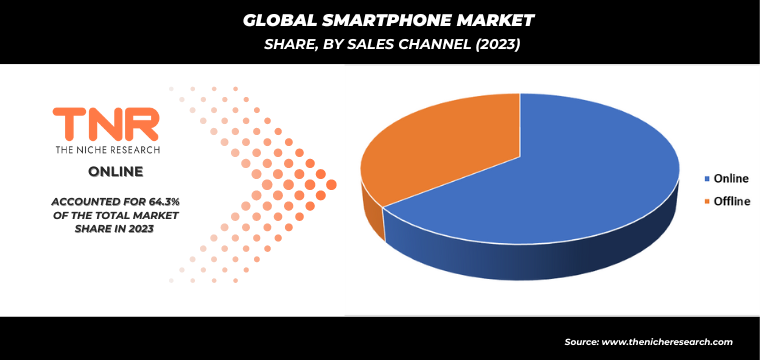
By Region, Asia Pacific dominated the Global Smartphone Market in 2023.
In the Asia-Pacific region, the demand for smartphones is driven by several key factors. Firstly, the rapid urbanization and economic growth in countries like China, India, and Southeast Asian nations have led to an expanding middle class with increased purchasing power. This demographic shift fuels the demand for smartphones as they become essential tools for communication, entertainment, and accessing online services. Additionally, the region’s young population is highly tech-savvy and embraces digital lifestyles, further boosting smartphone adoption rates.
The proliferation of social media platforms, e-commerce, and mobile gaming contributes to sustained demand for more advanced smartphone models with enhanced features and capabilities. Moreover, government initiatives to improve digital infrastructure and connectivity, coupled with aggressive marketing strategies by smartphone manufacturers, stimulate demand for the latest devices. As a result, the Asia-Pacific region remains a pivotal market for smartphone manufacturers, driving innovation and competition in the industry.
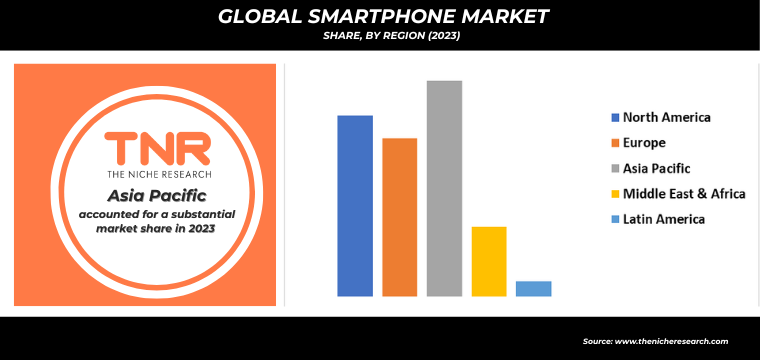
Competitive Landscape: Global Smartphone Market:
- Apple
- Asus
- HTC
- Huawei
- LG
- Motorola
- One Plus
- Oppo
- Samsung
- Sony
- Vivo
- Xiaomi
- Other Industry Participants
Global Smartphone Market Scope
| Report Specifications | Details |
| Market Revenue in 2023 | US$ 570.3 Bn |
| Market Size Forecast by 2034 | US$ 1,140.1 Bn |
| Growth Rate (CAGR) | 6.5% |
| Historic Data | 2016 – 2022 |
| Base Year for Estimation | 2023 |
| Forecast Period | 2024 – 2034 |
| Report Inclusions | Market Size & Estimates, Market Dynamics, Competitive Scenario, Trends, Growth Factors, Market Determinants, Key Investment Segmentation, Product/Service/Solutions Benchmarking |
| Segments Covered | By Operating System, By Price Range, By Sales Channel, By Region |
| Regions Covered | North America, Europe, Asia Pacific, Middle East & Africa, Latin America |
| Countries Covered | U.S., Canada, Mexico, Rest of North America, France, The UK, Spain, Germany, Italy, Nordic Countries (Denmark, Finland, Iceland, Sweden, Norway), Benelux Union (Belgium, The Netherlands, Luxembourg), Rest of Europe, China, Japan, India, New Zealand, Australia, South Korea, Southeast Asia (Indonesia, Thailand, Malaysia, Singapore, Rest of Southeast Asia), Rest of Asia Pacific, Saudi Arabia, UAE, Egypt, Kuwait, South Africa, Rest of Middle East & Africa, Brazil, Argentina, Rest of Latin America |
| Key Players | Apple, Asus, Google, HTC, Huawei, LG, Motorola, One Plus, Oppo, Samsung, Sony, Vivo, Xiaomi |
| Customization Scope | Customization allows for the inclusion/modification of content pertaining to geographical regions, countries, and specific market segments. |
| Pricing & Procurement Options | Explore purchase options tailored to your specific research requirements |
| Contact Details | Consult With Our Expert
Japan (Toll-Free): +81 663-386-8111 South Korea (Toll-Free): +82-808- 703-126 Saudi Arabia (Toll-Free): +966 800-850-1643 United Kingdom: +44 753-710-5080 United States: +1 302-232-5106 E-mail: askanexpert@thenicheresearch.com
|
Global Smartphone Market
By Operating System
- Android
- IOS
- Others
By Price Range
- Low Range (Below $200)
- Mid-Range ($201-$500)
- Premium (Above $501)
By Sales Channel
- Online
- Offline
By Region
- North America (U.S., Canada, Mexico, Rest of North America)
- Europe (France, The UK, Spain, Germany, Italy, Nordic Countries (Denmark, Finland, Iceland, Sweden, Norway), Benelux Union (Belgium, The Netherlands, Luxembourg), Rest of Europe)
- Asia Pacific (China, Japan, India, New Zealand, Australia, South Korea, Southeast Asia (Indonesia, Thailand, Malaysia, Singapore, Rest of Southeast Asia), Rest of Asia Pacific)
- Middle East & Africa (Saudi Arabia, UAE, Egypt, Kuwait, South Africa, Rest of Middle East & Africa)
- Latin America (Brazil, Argentina, Rest of Latin America)
Report Layout
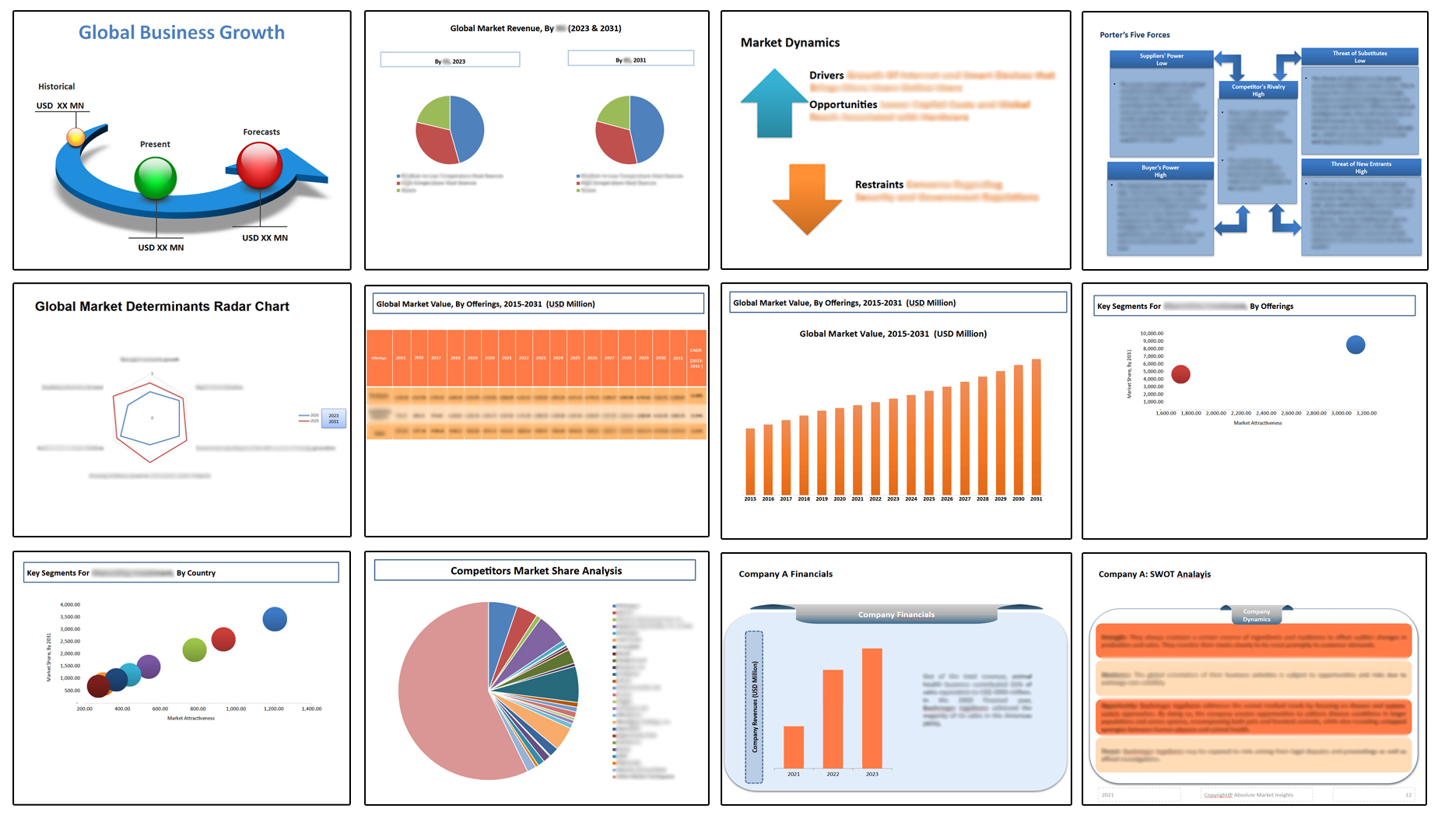
Table of Contents
Note: This ToC is tentative and can be changed according to the research study conducted during the course of report completion.
**Exclusive for Multi-User and Enterprise User.
Global Smartphone Market
By Operating System
- Android
- IOS
- Others
By Price Range
- Low Range (Below $200)
- Mid-Range ($201-$500)
- Premium (Above $501)
By Sales Channel
- Online
- Offline
By Region
- North America (U.S., Canada, Mexico, Rest of North America)
- Europe (France, The UK, Spain, Germany, Italy, Nordic Countries (Denmark, Finland, Iceland, Sweden, Norway), Benelux Union (Belgium, The Netherlands, Luxembourg), Rest of Europe)
- Asia Pacific (China, Japan, India, New Zealand, Australia, South Korea, Southeast Asia (Indonesia, Thailand, Malaysia, Singapore, Rest of Southeast Asia), Rest of Asia Pacific)
- Middle East & Africa (Saudi Arabia, UAE, Egypt, Kuwait, South Africa, Rest of Middle East & Africa)
- Latin America (Brazil, Argentina, Rest of Latin America)
The Niche Research approach encompasses both primary and secondary research methods to provide comprehensive insights. While primary research is the cornerstone of our studies, we also incorporate secondary research sources such as company annual reports, premium industry databases, press releases, industry journals, and white papers.
Within our primary research, we actively engage with various industry stakeholders, conducting paid interviews and surveys. Our meticulous analysis extends to every market participant in major countries, allowing us to thoroughly examine their portfolios, calculate market shares, and segment revenues.
Our data collection primarily focuses on individual countries within our research scope, enabling us to estimate regional market sizes. Typically, we employ a bottom-up approach, meticulously tracking trends in different countries. We analyze growth drivers, constraints, technological innovations, and opportunities for each country, ultimately arriving at regional figures.Our process begins by examining the growth prospects of each country. Building upon these insights, we project growth and trends for the entire region. Finally, we utilize our proprietary model to refine estimations and forecasts.
Our data validation standards are integral to ensuring the reliability and accuracy of our research findings. Here’s a breakdown of our data validation processes and the stakeholders we engage with during our primary research:
- Supply Side Analysis: We initiate a supply side analysis by directly contacting market participants, through telephonic interviews and questionnaires containing both open-ended and close-ended questions. We gather information on their portfolios, segment revenues, developments, and growth strategies.
- Demand Side Analysis: To gain insights into adoption trends and consumer preferences, we reach out to target customers and users (non-vendors). This information forms a vital part of the qualitative analysis section of our reports, covering market dynamics, adoption trends, consumer behavior, spending patterns, and other related aspects.
- Consultant Insights: We tap into the expertise of our partner consultants from around the world to obtain their unique viewpoints and perspectives. Their insights contribute to a well-rounded understanding of the markets under investigation.
- In-House Validation: To ensure data accuracy and reliability, we conduct cross-validation of data points and information through our in-house team of consultants and utilize advanced data modeling tools for thorough verification.
The forecasts we provide are based on a comprehensive assessment of various factors, including:
- Market Trends and Past Performance (Last Five Years): We accurately analyze market trends and performance data from preceding five years to identify historical patterns and understand the market’s evolution.
- Historical Performance and Growth of Market Participants: We assess the historical performance and growth trajectories of key market participants. This analysis provides insights into the competitive landscape and individual company strategies.
- Market Determinants Impact Analysis (Next Eight Years): We conduct a rigorous analysis of the factors that are projected to influence the market over the next eight years. This includes assessing both internal and external determinants that can shape market dynamics.
- Drivers and Challenges for the Forecast Period:Identify the factors expected to drive market growth during the forecast period, as well as the challenges that the industry may face. This analysis aids in deriving an accurate growth rate projection.
- New Acquisitions, Collaborations, or Partnerships: We keep a close watch on any new acquisitions, collaborations, or partnerships within the industry. These developments can have a significant impact on market dynamics and competitiveness.
- Macro and Micro Factors Analysis:A thorough examination of both macro-level factors (e.g., economic trends, regulatory changes) and micro-level factors (e.g., technological advancements, consumer preferences) that may influence the market during the forecast period.
- End-User Sentiment Analysis: To understand the market from the end-user perspective, we conduct sentiment analysis. This involves assessing the sentiment, preferences, and feedback of the end-users, which can provide valuable insights into market trends.
- Perspective of Primary Participants: Insights gathered directly from primary research participants play a crucial role in shaping our forecasts. Their perspectives and experiences provide valuable qualitative data.
- Year-on-Year Growth Trend: We utilize a year-on-year growth trend based on historical market growth and expected future trends. This helps in formulating our growth projections, aligning them with the market’s historical performance.
Research process adopted by TNR involves multiple stages, including data collection, validation, quality checks, and presentation. It’s crucial that the data and information we provide add value to your existing market understanding and expertise. We have also established partnerships with business consulting, research, and survey organizations across regions and globally to collaborate on regional analysis and data validation, ensuring the highest level of accuracy and reliability in our reports.








